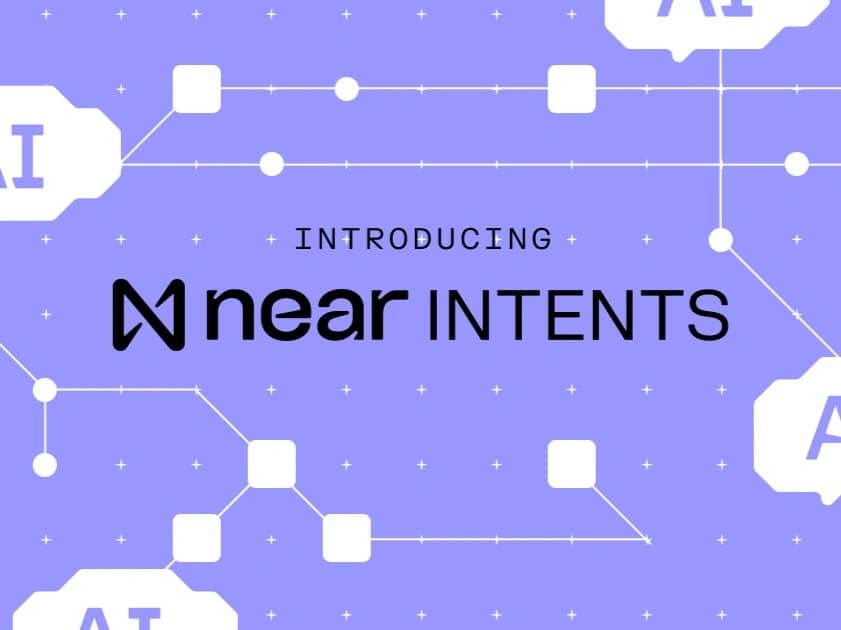订阅 wiki
Share wiki
Bookmark
NEAR Intents
NEAR Intents
NEAR Intents 是在 NEAR 协议 上开发的以意图为中心的基础设施。它旨在通过允许用户指定高级目标(称为意图),而不是直接构建低级交易来简化 Web3 交互。 这种方法抽象了技术复杂性,并为执行去中心化操作提供了一个结构化的途径。 [1] [4] [8]
概述
NEAR Intents 使用基于意图声明的模型取代了传统的交易签名工作流程。用户无需管理钱包、gas 费用和智能合约调用的详细方面,而是由链下求解器处理用户表达的意图(例如,将一种代币兑换成另一种代币)。这些求解器解释意图并生成相应的链上执行交易。
NEAR Intents 于 2024 年 11 月推出,并在 2025 年 ETHDenver 大会上宣布,作为链抽象计划的核心组成部分,旨在消除多链交互的复杂性。用户或 AI 代理定义他们期望的结果(意图),而求解器网络处理跨各种链、市场或 API 的执行。该协议是作为 开放代理联盟 下更广泛合作的一部分启动的,涉及 NEAR AI、Coinbase AgentKit、Eliza Labs、Aethir、Phala、Frax、Akash 等实体。 [1] [2] [8]
该系统提供了一个无需许可且可组合的模型。它支持跨多个用例的集成,包括去中心化金融 (DeFi)、游戏、治理和去中心化自治组织 (DAO)。该框架被认为是与 NEAR 协议 相关的更广泛的链抽象策略的组成部分。 [1] [2] [4] [5] [10]
历史
NEAR Intents的概念于2023年出现,旨在增强Web3的可访问性。该项目由NEAR基金会与ZK驱动的求解器市场Zingo Labs合作推出。最初的部署侧重于标准用例,例如代币交换和非同质化代币(NFT)购买,通过抽象钱包管理并简化链上操作。 [3] [10]
2024年,NEAR Intents在生态系统内的采用范围扩大,并进一步集成到区块链操作系统(BOS)前端和各种第三方平台。这些发展提高了互操作性,并将NEAR Intents定位为多个试点去中心化应用程序(dApps)和用户流程中使用的组件。 [3] [6] [7]
技术
核心概念
NEAR Intents 由 NEAR 协议 基于意图规范的概念创立。用户无需提供详细的、逐步的说明,而是声明他们期望的结果。这些声明通常表示为结构化的 JSON 对象,并由称为求解器的实体在链下处理。求解器负责根据提供的意图,通过利用可用的 智能合约 逻辑、链上流动性和外部数据源来构建有效的链上交易。 [1] [5] [2]
组件
- 意图 (Intent): 一种结构化的表示,通常采用 JSON 格式,概述了用户的预期结果。意图是所需结果的高级规范,可以在链上、链下或通过直接的对等通信发布。示例包括资产交换、代币转移、NFT 或 MT 提款以及法币转换。 [1] [5] [2]
- 求解器 (Solver): 一种链下代理,负责解释意图、组装适当的交易,并促进它们在链上执行。求解器也称为做市商,他们监控意图,计算策略,竞争报价以最优化地实现意图,并使用验证器智能合约执行交易。他们负责管理实现意图所需的流动性。 [1] [5] [8] [2]
- 验证器智能合约 (Verifier Smart Contract): 部署在 NEAR 协议 上的智能合约,用于验证和结算所有由意图产生的交易。该合约确保执行的完整性,并在必要时处理争议解决。 [1] [5]
- 授权层 (Authorization Layer): 协议机制,例如会话密钥或委托访问,允许求解器以受控和安全的方式代表用户进行操作。 [1]
协议设计
NEAR Intents 采用模块化架构,将用户意图的定义、求解器中包含的逻辑以及执行交易的过程分开。该设计支持可组合性,使各种求解器或服务能够集成并专注于不同的运营领域,例如金融交易或身份管理。 [1] [2] [3]
该协议包含三个基本属性:
- 无需许可: 意图的创建和求解器的注册对所有参与者开放。 [1]
- 可组合: 意图可以构建成链或嵌套配置,以实现更复杂的工作流程。 [1]
- 可互操作: 该协议旨在通过链抽象框架扩展对多链环境的支持。 [1] [8] [2] [3] [4] [5] [10]
流程
NEAR Intents协议遵循一个明确的流程,从用户最初声明的期望结果到最终结算和潜在的争议解决。
- 意图创建: 用户或代理通过应用程序、链上交易或API调用广播意图。
- 求解器发现: 求解器检测到新的意图,分析需求,并返回建议的报价。
- 用户选择: 用户选择一个报价,并通过链上签名确认。
- 执行: 求解器满足请求,可能跨多个区块链。
- 结算: 验证器合约完成交易,求解器重新平衡流动性。
- 争议解决: 内置机制允许处理执行失败或冲突。 这个多步骤流程允许用户表达高层次的目标,而链下求解器处理复杂的执行细节。 [2] [5] [14] [15]
支持的意图类型(截至2025年第一季度)
截至2025年第一季度,NEAR Intents协议支持多种用户意图类型,从而实现各种去中心化操作。
- 交换意图(Swap Intents)
- 转账意图(Transfer Intents)
- FT提现意图(FT Withdraw Intents)
- NFT提现意图(NFT Withdraw Intents)
- MT提现意图(MT Withdraw Intents)
- 原生代币提现(Native Token Withdrawals) 这些支持的类型允许用户执行诸如交换代币、转移资产以及提取各种代币标准(包括同质化代币 (FT)、非同质化代币 (NFT) 和多代币 (MT))以及原生链资产等操作。 [2] [19] [14] [15]
集成和 API
为了方便集成并提供对 NEAR Intents 系统的访问,开发者和用户可以使用多个 API 和工具。
- 1Click Swap API: 一个 REST API,通过抽象后端复杂性,允许将 NEAR Intents 快速集成到应用程序和钱包中。
- Intents Explorer API: 一个公共 API,用于跟踪和分析历史意图和交易状态。
这些 API 使开发者能够轻松地将基于意图的功能集成到他们的应用程序中,并提供对 NEAR Intents 协议中发生的活动的透明度。 [16] [17] [18]
NEAR Shade Agents
Shade Agents 是一种自主代理,它结合了智能合约、可信执行环境 (TEE) 和链签名,以安全且可验证的方式跨区块链进行交易。它们能够:
- 签署任何链上的交易
- 托管和交易加密资产
- 访问链下 AI 模型、API 和数据
- 通过基于 TEE 的计算来保护隐私[11]
涉及的技术
NEAR Intents 和更广泛的 NEAR AI 代理生态系统利用多项关键技术来实现自主、多链操作和结果驱动的交易。
- 可信执行环境 (TEE): 由 Shade Agent 堆栈中的工作代理使用,该堆栈为利用 Intents 的某些应用程序提供支持。 TEE 为代理提供安全的硬件飞地,以安全地访问链下数据并执行决策,同时保持隐私和完整性。 [11] [12]
- 链签名: 一项核心组件,使 NEAR 账户(包括智能合约和 AI 代理)能够直接在其他区块链协议(如 比特币、以太坊 和 Solana)上签名和执行交易。 这项技术促进了多链交互和去中心化密钥管理,这对于 Intents 框架内的跨链交易和资产管理至关重要。 [11] [12] [13] [8]
- Kaito API: 提供实时市场情绪数据,特别是从各种在线平台收集的“代币关注度”指标。 AI 代理(例如 Mindshare Index Agent)利用此数据源来通过 Intents 告知交易决策和策略执行。 [12]
- 大型语言模型 (LLM): 充当生态系统中运行的代理的 AI“大脑”。 LLM 处理和分析复杂的数据输入、解释上下文、评估情绪并预测结果,使代理能够做出复杂的决策并制定策略,然后通过 NEAR Intents 协议执行这些策略。 [11] [12]
使用案例
NEAR Intents 适用于多种场景:
- 代币兑换: 促进代币交换的执行,而无需直接与去中心化交易所界面交互。
- 用户引导: 为新用户提供结构化的流程,以获取加密资产或与dApp交互,而无需管理种子短语或钱包。
- DAO 运营: 支持去中心化自治组织内提案提交、投票和资金等流程的自动化。
- 游戏: 实现安全的游戏内资产交换和任务完成,而无需详细管理区块链交易。
- 跨链功能: 通过链抽象支持涉及跨多个区块链网络传输代币或管理头寸的活动。
生态系统
NEAR Intents 已集成到 NEAR 生态系统中的各种项目和去中心化应用程序中。主要贡献来自 NEAR 基金会 和 Zingo Labs,并得到社区参与者的额外支持。将 NEAR Intents 集成到 BOS 中进一步增强了与去中心化应用程序交互的用户界面。 [10]
该协议的采用带来了显著增长,使其成为跨链 DeFi 的统一流动性层。2025 年 11 月 16 日宣布,NEAR Intents 的历史交易额已超过 50 亿美元。交易成功率和求解器效率等性能指标由 Flipside Crypto 和 Dune Analytics 等数据跟踪平台监控。 [20] [6] [7]
NEAR Intents 属于 Web3 中基于意图的用户体验的更广泛运动。与 以太坊 的账户抽象和 Cosmos 的链间账户等模型概念相似,NEAR Intents 通过其对链抽象和对全栈开发者工具的支持而脱颖而出。它的框架允许可定制的授权和模块化意图声明,使其成为去中心化领域中的一种通用解决方案。
未来发展
NEAR 协议的长期战略将 NEAR Intents 作为链抽象的基础要素,用户交互被简化为高级目标。计划中的发展包括:
发现错误了吗?
